Pear trees are grown in gardens for their delicious fruits. Pear fruits have full of lots of nutrients. Pear trees are one of the easiest fruit trees to grow in your backyard garden. Don’t risk losing this delicious crop. Keep an eye on the pests and diseases of the Pear tree that can cause severe damage to your tree.
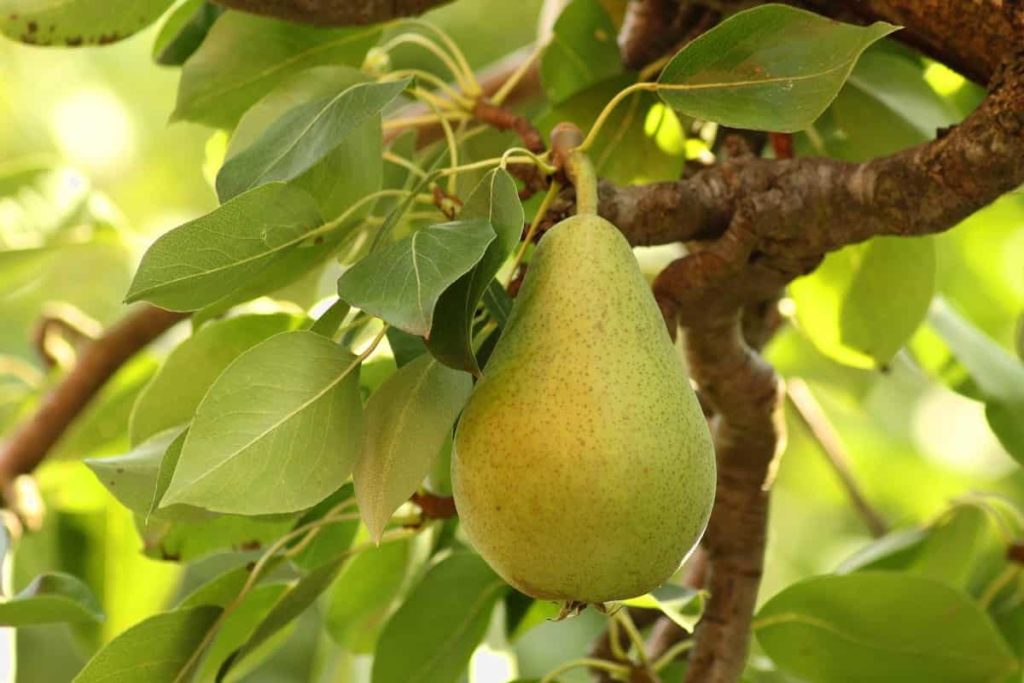
Pear trees also suffer from some growing problems. Pests that don’t affect your crop can spread the disease, so you still need to control them. Several diseases can cause serious problems. The sooner you get the problem, the easier it will be to treat them. Let’s check out 16 common Pear tree problems below.
Common Pear tree problems
Pear tree leaves turn brown
Pear trees often get brown leaves from dehydration. Other stressors such as extreme weather, pests, and diseases can also cause this. Generally, if the leaves look dry, it is likely dehydrated.
Underwater
When Pear trees get underwater, their leaves usually start to turn in the color yellow before browning and falling. The tree becomes more prone to pests and diseases during this process.
Solution – Compost is not only very good at providing enough nutrients but increasing soil wealth and holding water. Mulch benefits include temperature regulation, reduced evaporation, and adding nutrients after the mulch breaks. Place the mulch at least 3 inches away from the tree stem.
Extreme weather
Pear trees can usually handle temperatures between 0 to 30°C but become stressed when there is an early frost, extreme heat, or weather swings. This stress causes the tree’s leaves, flowers, and fruits to turn brown and fall.
Solution – To prevent this, monitor the swings in the weather and shelter the tree if possible. Provide 2 inches of manure and 4 inches of mulch. Fertilizer provides valuable nutrients and increases soil (source) water retention, while mulch regulates soil temperature and reduces vapor. Shade the Pear trees from the afternoon sun. Protect the tree canopy with sheets of cardboard at the time of frost.
Pests and diseases
Pear trees get brown leaves due to pests and diseases such as aphids, mites, rust, and fire blight.
Solution -Most pests can be prevented with water, oil, or spray, while you can treat diseases with organic sprays or fungicides. You can prevent some pests and diseases like aphids can be prevented with companion plants like garlic.
In case you missed it: Best Fertilizers for Pear Trees: Organic, Homemade, Liquid, Natural, NPK, Compost, How and When to Apply
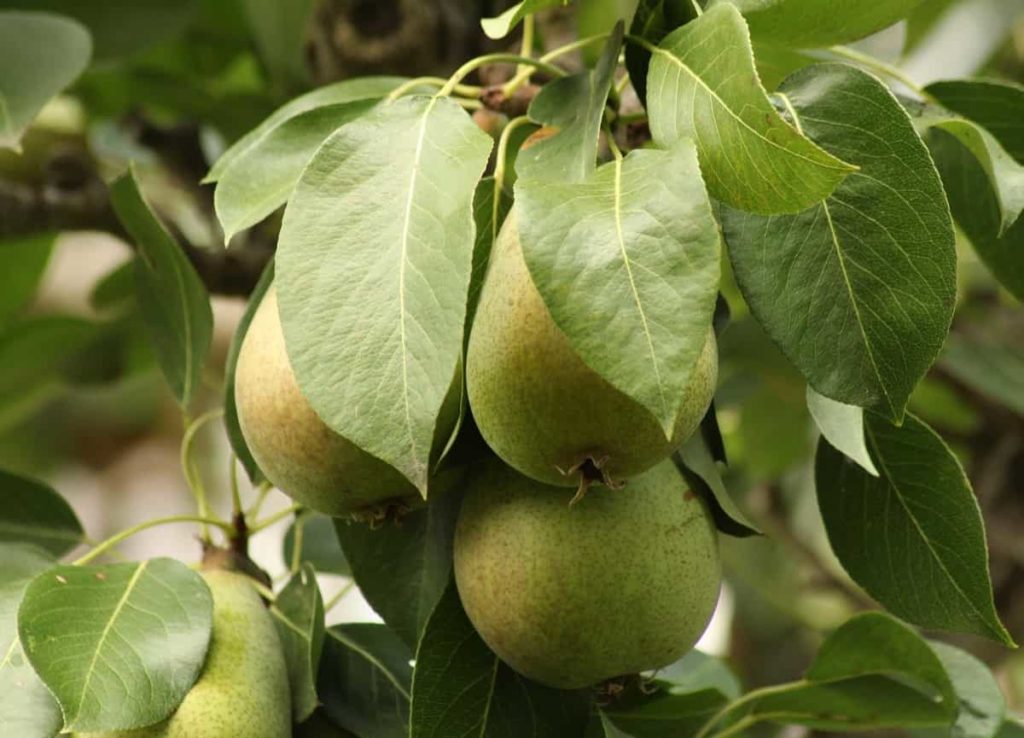
Pear tree leaves curling
Pear trees get curling leaves from underwater, hot weather, transplant shocks, and pests and diseases such as aphids and fire blight. You can use organic sprays to eliminate pests and diseases.
Underwater
Common symptoms of underwatered Pear trees are leaf curling, browning, and dropping. When drying, the leaves curl to preserve moisture, and if they are left without water for long, they will start browning (will die) and fall off the tree.
Solution – It is easy to give underwater because it is difficult to tell how much moisture the soil holds. It gets worse if you’re experiencing excessively hot weather or drought times (more on them later). Provide 2 inches of compost every 1 to 2 months and 4 to 12 inches of mulch every 3 to 6 months. When applying, place these materials at least 3 inches away from the Pear tree to prevent mold.
Heat stress
In hot and dry climates, Pear trees lose moisture quickly from their leaves and soil. Usually, Pear trees cool themselves by sending moisture from their roots to their leaves and by transpiration.
Solution – Not only apply 2 inches of manure to provide nutrients for your Pear tree but also keep more water in the ground and help prevent drought pressure. Like compost, mulch goes a long way in maintaining water but offers other benefits like regulating its temperatures, such as shedding and insulating soil.
Transplant shock
If the Pear tree was planted recently and has started to die, it is probably due to a transplant shock. The transplant shock occurs when the plant is exposed to a new environment and has to establish a new root system. Avoid transplants unless necessary, as recovery can take up to 1 year.
Solution – Like many plants, Pear trees suffer from transplant shocks that can take up to a year to recover. To help avoid transplant shock, apply 2 inches of compost and 4 inches of mulch over the soil. Pour water regularly and add more soil as needed.
Droopy Pear tree leaves
Pear trees usually drop their leaves early due to a stressful change in water, nutrients, or environment. Moreover, Pear trees soon lose their leaves due to pests and diseases such as aphids, scab, and fire blight. The tree should grow its leaves again after solving this problem.
Seasonal
Like many other fruit trees, Pear trees usually lose their leaves in the fall. Usually, leaves turn yellow and brown before falling. If your Pear tree leaves turn yellow and red and fall in autumn, know that it’s normal, and they’ll grow their leaves again in the spring.
Under or overwater
Pear trees quickly lose their leaves due to under and overwater. Generally, underwater symptoms include leaf curling, drying, and browning before falling. On the other hand, the high-watering signs are dropping green leaves and swampy-smelling soil. Over time, it leads to root rot, a water mold, which decays roots and can kill a Pear tree.
In case you missed it: Pear Gardening For Beginners – How To Start, FAQs

Solution – If you have a Pear tree, the best way to modify its soil is to repot the tree with fresh potting soil. Repotting the tree into a large pot every 3 to 5 years is also a great process to prevent root binding. Add organic amendments like compost to improve soil wealth and drainage for this problem.
Nutrient deficiency
A lack of nutrients can cause Pear tree leaves to fall. This is usually caused by nitrogen deficiency, though other deficiencies can also cause it.
Solution – Provide a standard 10-10-10 fertilizer or compost to the Pear tree for best results. These materials provide a large number of traceable nutrients. Although chemical fertilizers contain nutrient content, many farmers are finding that they lack quality and cause problems such as poor water retention, declining soil health, and an increase in pests and diseases. As a result, many people are learning that compost and manures not only contain nutrients in both quantity and quality but can also replace fertilizers.
The Pear tree is not blooming
If your Pear tree didn’t bloom this year, first determine if it’s a mature tree. If a very small Pear tree didn’t bloom, it could be much smaller. If your tree is less than five years old, your best bet is to wait. Coming to mature trees, dehydration can also cause a mature Pear tree to fail to bloom.
Solution – Providing deep water during the growing season every week can go a long way toward blooming the Pear tree. Improper pruning or additional fertilization of Pears can cause Pear trees to not bloom. Flowers appear on small spurs on Pear trees. Cutting branches too hard can reduce or eliminate flowers. Too much fertilizer forces the tree to grow branches and leaves rather than flowers. You should not overfertilize Pear trees.
Pear tree dying
Pear trees usually die from inappropriate water, nutrients, or climate. However, transplant shocks, pests, and diseases can also affect them. For best results, water only when the soil is dry, apply compost, and plant 4 to 8 plants.
Under or overwater
Solution – While there is a lot of information about watering plants, the best rule is to give water only when the soil is dry. It prevents both over and underwater as you only water when the plant needs it.
Climate
Pear trees require full sunlight or an average of 8 hours a day to thrive and may die if adequate sunlight is not provided. Furthermore, the Pear tree prefers a pH between 6.2 and 6.8 or a little acidic.
Solution – While Pear trees can withstand fluctuations in soil pH, intense acidic soil can kill a Pear tree. Use lime to reduce soil pH if necessary.
Infection
Several infectious diseases harm Pear trees, including fire blights and bacteria. All these infections can cause severe damage to the leaves and fruits of Pear trees and, if not treated, defoliate trees to the extent that they cannot support their life cycle.
Solution – Plant-resistant types and using fungicides can prevent infections. These diseases require removal and destruction to prevent the spread of affected trees.
Physical damage
Trees are so large that they can withstand the occasional wound caused by inappropriate pruning or heavy winds.
Solution – Protecting Pear trees by covering them with fences or large trees can help reduce the potential damage caused by nature and prevent the damage from being overdone by using the right pruning techniques.
Pear trees turning yellow
Nitrogen deficiency
Small leaves falling from the stem and yellow old leaves indicates the lack of nitrogen in the Pear tree.
Solution – Scattering high nitrogen urea fertilizer and watering the soil around the tree removes this deficiency. Repeat only with a re-diagnosis of the problem.
Iron deficiency
Iron deficiency produces new leaves with green veins. In severe cases, the stunted leaves are almost white, with yellow edges and tips. Damaged roots and poorly drained or compacted soil multiply the effects.
Solution – Iron chelate foliar spray applied on soil provides a temporary treatment. Always use fertilizers, soil modifications, and foliar spray on the manufacturer’s recommended strength.
Potassium deficiency
The potassium deficiency causes the chlorotic leaf margins and the interveinal tissues. The damage spreads inward, eventually killing the entire leaf.
Solution – Potassium nitrate or potassium sulfate worked in soil or fed regularly with potassium fertilizers to restore potassium levels.
Manganese deficiency
Pear trees lacking manganese have green, yellow new leaves. As their manganese stores diminish, dead spots develop between their veins. This deficiency usually affects plants in poorly drained or alkaline soil.
Solution – This deficiency is removed by adding manganese sulfate to the soil. Manganese chelate foliar spray temporarily relieves symptoms.
Zinc deficiency
Zinc-deficient Pear leaves are small, narrow, and pointed, with solid yellow color. They sometimes contain dead spots. All these problems arise when the soil is alkaline or phosphorus.
Solution – Zinc fertilizers treat this deficiency. Use zinc chelate foliar spray or soil modification for faster but temporary improvements.
In case you missed it: Planting A Pear Tree – A Full Guide
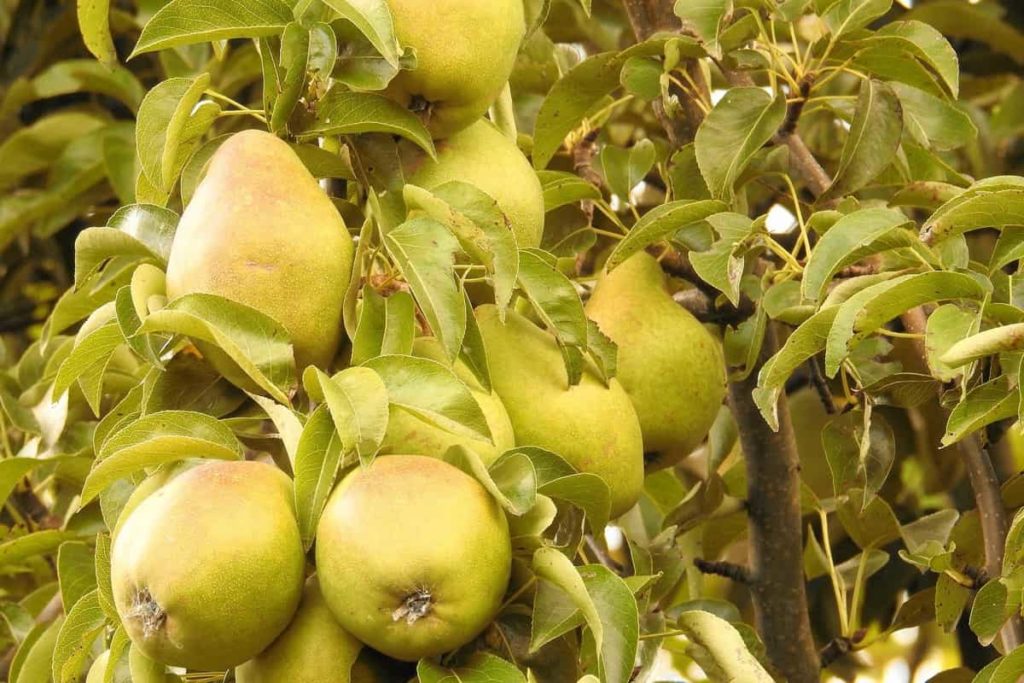
Pear scab
Pear leaves turn to dark olive green with yellow spots indicating a scab infection. Scab strikes in spring when rain or irrigation splash spores from fallen to healthy leaves.
Solution – Immediate removal and destruction of fallen leaves and morning water to reduce drying time.
Pests
Aphids
These small pests group under leaves, suck plant sap and leave honeydew. It leaves a growth media for the sooty mold to be built on your Pear trees.
Solution – Generally, aphids are not a big deal unless they get out of hand. You can drop them from a tree with water jets from your hose. Neem oil or other insecticidal oil kills eggs; many pesticides work for the aphids.
Codling moth
They cause burrows and holes in Pear fruits. These holes are often blocked by brown frass. Some holes are shallow, but others burrow deep into the fruit, reaching the core.
Solution – Preventive measures are necessary, so ensure you learn the appropriate technique for fruit tree maintenance. You can also use Entrust and kaolin clay applications to treat these pests. Most home gardeners remove the affected fruit by hand before releasing the larvae’s fruit. This is an easy way to reduce population. If you see an affected fruit, toss it or burn it to prevent them from coming out and going to the next fruit.
Leafrollers
These pests roll the leaves of the Pear tree and tie them to the silk webbing. Larvae cause the most damage to Pear trees, so monitor any sign of adult pests in your garden.
Solution – To fix this problem, use Entrust or Bacillus thuringiensis. These are effective, organic treatment options. Make sure you spray carefully; it needs to go inside rolled leaves where the larvae like to hide and feed.
Pear psylla
It is a harmful pest for Pear trees and is mostly known to develop resistance to pesticide options.
Solution – If you end up with Pear psylla pests in your garden, use insecticidal oil and kaolin clay to eliminate the population. It is generally better to spray during dormant weather as Pear psylla likes more than winter on trees. If you catch them when they are inactive, it is easy to eliminate them.
Diseases
Fire blight
Brown or black leaves indicate the presence of fire blight, caused by bacteria that also affect Apples and Roses. Suppose the cankers continue to grow around the stem circle. In that case, they eventually surround the tree, making the new leaves smaller and the colors fall earlier than expected, and the tree will eventually die.
In case you missed it: Growing Custard Apple in Containers (Sitaphal)
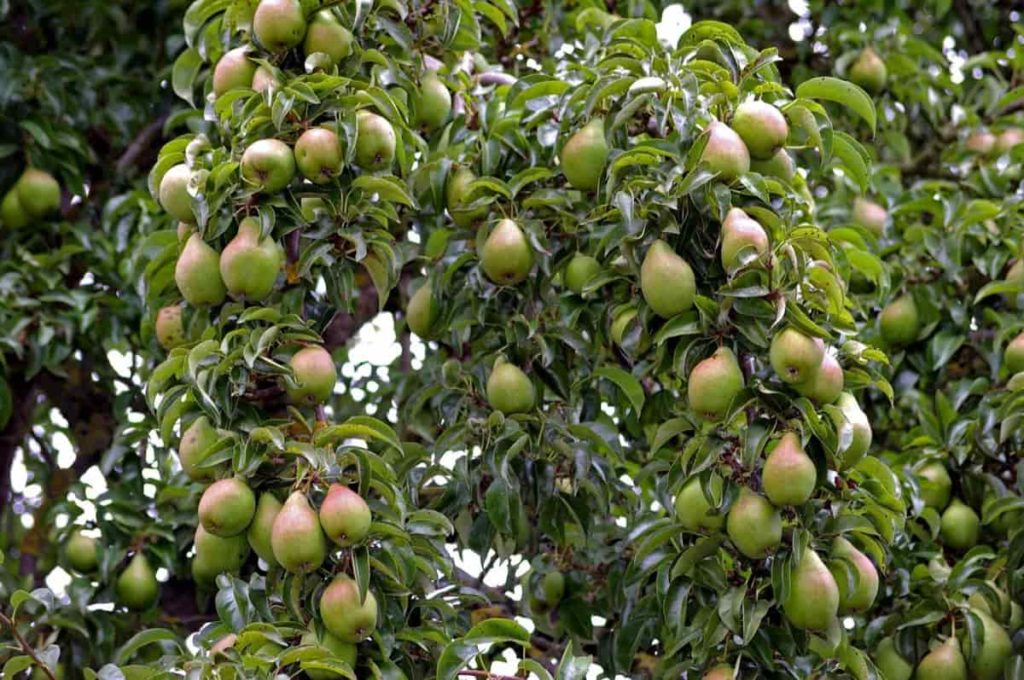
Solution – Because there are no good chemical remedies to control the fireblight, your best control is to keep your Pear tree healthy. Plant disease-resistant Pear types. Make sure the tree has at least six hours of sunshine and good air circulation daily, and use proper pruning techniques.
Fungus spots
Some fungus can cause spots on leaves that eventually kill the leaf itself, but not the Pear tree. Anthracnose appears as brown spots or long pigmentation on leaves and can cause many leaves to fall, but it is primarily a surface problem and will not cause severe damage.
Solution – Pull or clip off leaves with fungus spots, and dispose of them away from trees and any garden.
Powdery mildew
White, powdery mold stained on leaves or trunks means your Pear sits with powdery mildew. Later, spots will darken, and leaves can turn yellow and die. The wrong-shaped fruit, which has powdery sections, may also affect your Pear crop.
Solution – Keep the disease away with good growing methods, remove the leaves and stem of the disease, and if you cannot control the disease by removing the leaves with the disease, use the fungicides as instructed.
Crown, Collar, and Root rot
Your Pear trees may struggle with crowns, collars, or root rots. Crown rot is in stock bark tissue, while root rot affects roots. The collar rotting affects the tree’s family part (the top of the graft joint). The disease usually occurs when there is poor drainage soil and standing water around your Pear tree.
Solution – Prevention is the best option, including proper water management and never giving too much water to your Pear trees.
Pear decline
Pear decline is a phytoplasma disease spread by the Pear psylla pest. You will see the red and rolling of upper leaves in your Pear tree canopy with a drop of leaves prematurely. The Pear decline also causes a reduction in the size of leaves and fruits on your tree.
Solution – Getting rid of the Pear decline on your trees is impossible. No treatment is effective. The best options are to apply resistant or tolerant rootstocks and control Pear psylla on your trees.
In case you missed it: Apple Tree Growing Tips, Ideas, and Secrets
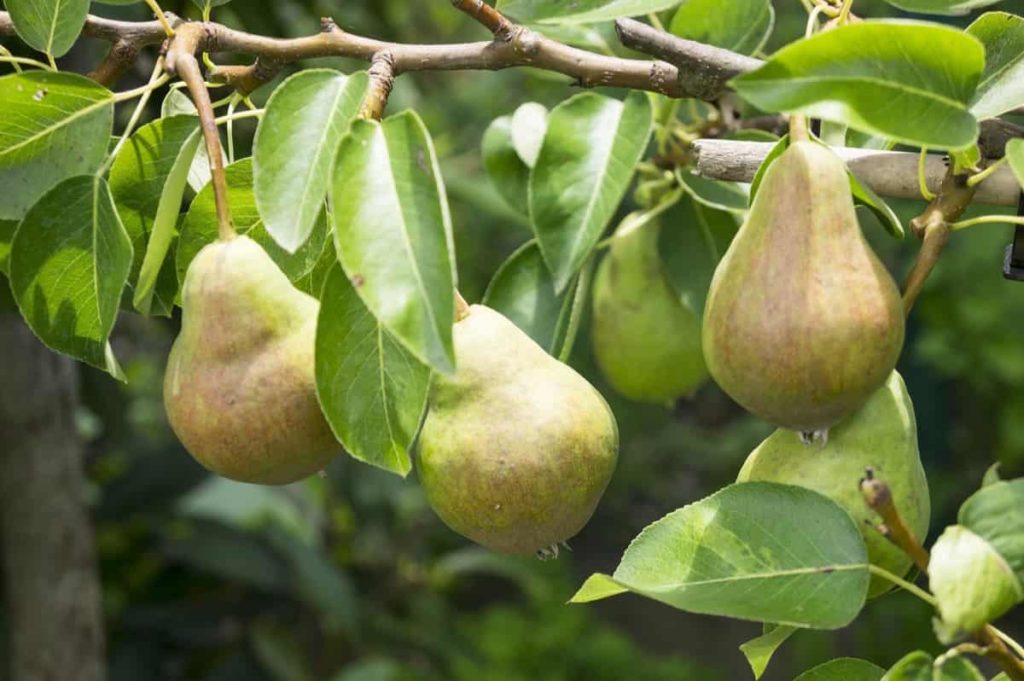
Septoria leaf spot
This infection mainly remains on the upper surface of leaves. You can see grey-white spots with purple margins that become clearer on maturity. As the disease progresses, it causes leaves to fall from the Pear tree in the late summer.
Solution – You should use suitable fungicides to get rid of this disease.
Conclusion
Growing Pear trees can be a rewarding experience for gardeners, but before you start, there are some things you need to know about problems occurring when growing Pears. If you have a garden with Pear trees, expect to face problems with Pear tree diseases and pests. Both are related, as pests can spread or facilitate other problems of the Pear tree. You can prevent many problems with proper spray and pruning. Keep a close watch on your trees and keep an eye on any signs to help overcome the problem as soon as possible.
- Broccoli Seed Germination and Selection
- Asparagus Seed Germination and Variety Selection
- Seasonal Flower Gardening: Best Practices for Spring, Summer, Fall, and Winter
- How to Grow Hibiscus from Flower
- Plantation Ideas for Home Decoration: A Beginners Guide
- Flower Garden Designs and Layouts for Beginners
- Planting and Spacing Techniques in Papaya: A Beginner’s Guide
- Growing Gold: Essential Techniques for Planting Pineapples
- How to Make Kalanchoe Plant Bushy: Home Remedies and Solutions
- 11 Reasons Why Your Gardenia is Not Blooming: Home Remedies and Solutions
- Eco Elegance: The Guide to Designing a Drought-Tolerant Landscape
- Gardening on a Slope: Strategies for Hillside Landscaping
- Nourish and Flourish: Top Organic Mulches for Thriving House Plants
- Everything You Want to Know about Indian Mogra Flower: Discover Uses and Growing
- Green Thumb Success: Expert Tips for Cultivating Greenhouse Pumpkins All Year Round
- Maximize Growth & Flavor: The Ultimate Guide to Companion Planting in Herb Gardens
- How to Control Rhododendron Problems Naturally: Home Remedies and Organic Ways to Fix Them
- Natural Magic: The Remarkable Benefits of Cinnamon for Plants
- Best Steps to Revive Dying Tulip with Natural and Organic Treatment
- 10 Reasons Why Your Angel Trumpet is Not Blooming: Remedies and Treatment
- How to Fix Periwinkle Leaf and Flower-Related Problems: Natural Remedies and Solutions
- How to Fix Zinnias Leaf and Flower Problems: Discover Natural and Home Remedies
- Organic Steps to Induce Lemon Tree Flowers: A Comprehensive Guide
- Bloom Booster: Crafting the Perfect Homemade Bougainvillea Fertilizer
- Optimizing Growth: A Guide to Applying NPK Fertilizer for Potted Plants
- 10 Best Homemade Fertilizers for Rubber Plant: DIY Recipes and Application Method
- How to Boost Female Pumpkin Flowers: Effective Steps for More Flowers and High Yields
- Transform Your Indoor Garden: Top Benefits of Pink Salt for Houseplants
- 10 Best Homemade Fertilizers for Peacock Plants (Calathea): Easy DIY Guide
- Unlock Blooms: 9 Reasons Why Your Potted Chrysanthemum is Not Blooming
- 8 Reasons Why Your Potted Hibiscus is Not Blooming: Fix it with Simple Solutions
- Unlock Blooms: 9 Key Reasons Your Potted Frangipani Won’t Flower
- 10 Reasons Why Is My Ice Plant Not Blooming: Remedies and Treatment
- 10 Reasons Why My Potted Hydrangea Not Blooming: Treatment and Remedies
- 10 Reasons Why is My Wisteria Not Blooming: Remedies and Treatment
- 10 Reasons Why is My Goldfish Plant Not Blooming: Remedies and Treatment